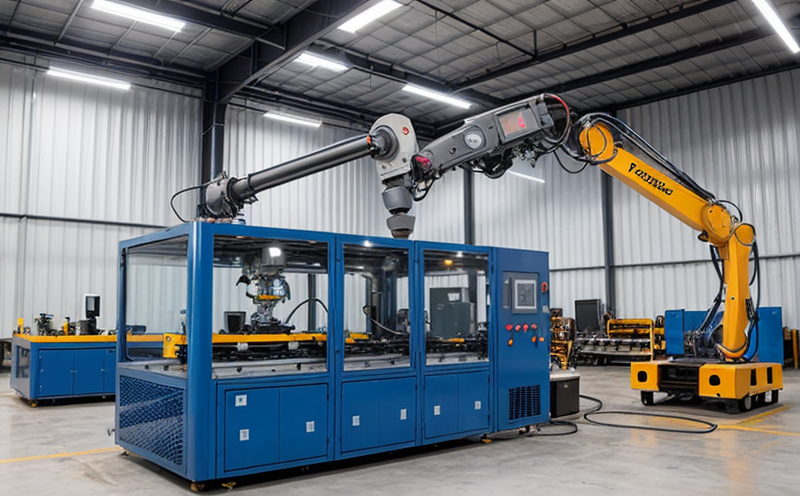ISO 9285 Noise Emission Testing of Robots
The ISO 9285 standard provides a framework to measure noise emissions from industrial robots. This testing is essential for ensuring that robotic systems comply with environmental regulations and meet the expectations of end-users regarding noise levels in both manufacturing and processing environments.
Compliance with noise emission standards like ISO 9285 helps manufacturers enhance their reputation by demonstrating commitment to reducing noise pollution, which can be a significant factor when selecting suppliers or upgrading equipment. This test ensures that robotic systems operate within acceptable noise limits, thereby promoting safer working conditions for operators and maintenance personnel.
Our laboratory specializes in performing comprehensive ISO 9285 compliance testing on industrial robots of all sizes and complexities. We follow the strict procedures outlined by the standard to ensure accurate and consistent results. Our team uses state-of-the-art equipment and methodologies to capture noise emissions under various operating conditions, providing clients with detailed reports that highlight any areas where improvements are necessary.
Testing is conducted in controlled environments simulating real-world industrial settings. This approach allows us to assess the performance of robotic systems across different scenarios, ensuring that they meet regulatory requirements for both indoor and outdoor use. By adhering strictly to ISO 9285 guidelines, we guarantee reliable test outcomes that are crucial for maintaining compliance with international standards.
Our service includes not only testing but also providing recommendations based on our findings to help clients optimize their robotic systems further. This could involve adjusting operational parameters or implementing design changes aimed at reducing noise emissions without compromising functionality.
In summary, ISO 9285 noise emission testing is a critical component of any industrial robotics and automation system's lifecycle management strategy. It ensures that these sophisticated machines contribute positively to the overall acoustic environment while enhancing productivity through efficient operation.
| Application | Description |
|---|---|
| Noise Emission Testing | Determines compliance with ISO 9285 standards for industrial robots. |
| Environmental Impact Assessment | Evaluates noise impact on surrounding areas and personnel. |
| Compliance Verification | Aids in meeting regulatory requirements pertinent to noise emissions. |
| Product Development | Assists in refining product design for quieter operation. |
Why It Matters
Compliance with ISO 9285 standards is not merely a compliance exercise; it plays a pivotal role in ensuring the safety and well-being of workers within industrial environments. Noise pollution from robotic systems can lead to health issues such as hearing loss, stress, and decreased productivity among employees who are exposed daily to high levels of noise.
Moreover, meeting these standards enhances a company's image by demonstrating its commitment to sustainability and worker welfare. It contributes significantly towards maintaining a healthy working environment which is crucial for attracting skilled labor and fostering innovation within the organization.
- Health Impact: Continuous exposure to excessive noise can cause long-term damage to human hearing.
- Safety Concerns: Excessive noise might distract operators, leading to potential accidents.
The importance of ISO 9285 compliance extends beyond mere regulatory adherence; it reflects a broader responsibility towards creating sustainable workplaces that prioritize both productivity and employee welfare. By adhering to these stringent standards, companies can position themselves as leaders in responsible manufacturing practices.
Applied Standards
The ISO 9285 standard provides clear guidelines for measuring noise emissions from industrial robots. It specifies the methods used to conduct tests and interpret results accurately. This ensures that all measurements are consistent across different testing facilities worldwide, facilitating international comparisons when necessary.
Our laboratory strictly adheres to these standards during our noise emission testing process. We employ calibrated sound level meters (SLMs) capable of measuring octave bands over the frequency range specified in ISO 9285. These instruments allow us to capture precise data points that reflect actual operating conditions of robotic systems.
The standard also outlines criteria for determining acceptable noise levels based on robot type and application. For instance, quieter robots used in sensitive environments like hospitals or residential areas would have stricter limits compared to those deployed in heavy-duty industrial applications where ambient noise is already high.
By following these internationally recognized standards, we ensure that our clients receive reliable test results which are credible both locally and globally. This consistency helps manufacturers make informed decisions regarding their robotic systems' design and performance optimization efforts.
Industry Applications
- Automotive Manufacturing: Ensuring compliance with noise emission regulations in assembly lines where sensitive components are being produced.
- Pharmaceutical Processing: Maintaining strict acoustic conditions to prevent contamination during production processes requiring precise handling of medicines or chemicals.
Robotics and automation systems play a crucial role across numerous sectors, from electronics manufacturing to food processing. Each industry has unique requirements regarding noise control measures due to varying factors such as operational complexity, proximity to human operators, and environmental sensitivity.
In automotive manufacturing, for example, ISO 9285 compliance ensures that robotic arms used in final assembly stages do not interfere with the delicate processes involved in fitting intricate parts together. Similarly, pharmaceutical companies must adhere strictly to noise limits set by ISO standards when deploying robots within sterile areas to avoid introducing contaminants.
| Industry | Description |
|---|---|
| Aerospace Manufacturing | Ensuring minimal disturbance during critical assembly processes in highly sensitive environments. |
| Metal Fabrication | Promoting safe working conditions by reducing noise levels close to machines where workers spend extended periods near robotic arms. |
Each application area has its specific challenges and considerations related to noise emissions. Our laboratory ensures that every test conducted meets the unique needs of each industry, helping clients achieve optimal performance from their robotic systems while adhering strictly to global standards.





